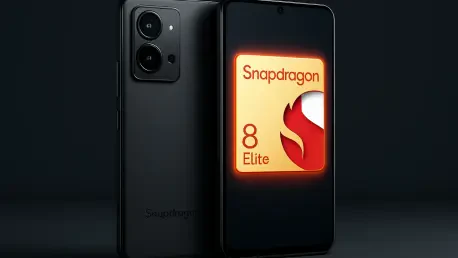Imagine a smartphone that not only keeps up with your busiest days but anticipates your needs, delivers console-quality gaming, and captures cinematic videos—all in the palm of your hand. The Snapdragon 8 Elite Gen 5, unveiled by Qualcomm, has sparked excitement across the tech industry as a chipset promising to redefine mobile experiences. This roundup gathers opinions, tips, and reviews from various industry perspectives to uncover how this cutting-edge processor is shaping flagship devices in 2025. By compiling insights from developers, tech analysts, and brand representatives, the goal is to provide a comprehensive look at what this technology means for consumers and the mobile landscape.
Unpacking Performance and Power: What Experts Are Saying
Industry analysts have been quick to highlight the Snapdragon 8 Elite Gen 5’s third-generation Oryon CPU, which boasts a 20% performance increase and 35% better power efficiency compared to its predecessor. Many note the octa-core setup, with prime cores reaching speeds of 4.6GHz, as a standout feature for raw processing power. This leap is seen as a benchmark for flagship devices, with some suggesting it could handle tasks previously reserved for laptops.
On the efficiency front, opinions vary slightly. While some tech reviewers emphasize the chipset’s ability to deliver up to 16% overall power savings—equating to nearly two extra hours of gaming—others question whether everyday users will notice these gains in casual use. A segment of analysts argues that such improvements cater more to power users, like gamers or content creators, rather than the average consumer scrolling through social media.
Differing views also emerge on adoption challenges. Certain industry voices point out that while the 3nm process is cutting-edge, app developers must optimize software to fully leverage this power. Without widespread optimization, the performance boost might remain underutilized, leaving some flagship devices with untapped potential.
Gaming Prowess: Developer and Gamer Perspectives
Game developers have expressed enthusiasm for the chipset’s support for Unreal Engine 5, which promises console-quality visuals on mobile devices. Enhanced Ray Tracing, improved by 25%, along with features like Tile Memory Heap for smoother performance, are frequently cited as game-changers. Developers see these tools as opportunities to craft more immersive experiences without sacrificing frame rates.
Gamers, on the other hand, offer a mixed outlook. Many are excited about Mesh Shading for optimized visuals, believing it could bring desktop-grade gaming to smartphones. However, some raise concerns about battery drain during extended play sessions, questioning whether the power efficiency gains will hold up under heavy load. Tips from gaming communities often include adjusting settings to balance performance and battery life.
A third perspective comes from tech bloggers who stress the importance of developer adoption. They note that while the hardware is ready for next-level gaming, the ecosystem needs more titles designed to exploit these capabilities. Until that happens, the full impact on mobile gaming might remain limited for mainstream audiences.
AI Innovations: Industry Takes on Smarter Smartphones
The AI capabilities of the Snapdragon 8 Elite Gen 5, particularly the 37% faster Hexagon NPU and upgraded Qualcomm Sensing Hub, have sparked widespread discussion. Tech innovators highlight how on-device AI assistants can learn and adapt in real time, offering personalized recommendations like app suggestions or context-aware reminders. This is seen as a step toward truly intelligent devices.
Regional differences in adoption are a point of contention. Analysts focusing on Asian markets predict rapid integration of these AI features due to high consumer demand for smart tech, while North American perspectives suggest slower uptake due to privacy concerns. Some industry watchers advise brands to prioritize transparency in how data is handled to build user trust.
Privacy remains a hot topic across the board. While on-device AI is touted as more secure than cloud-based systems, certain critics argue that continuous learning systems could still raise questions about data retention. Recommendations often include clear user controls and opt-out options to address skepticism and ensure broader acceptance of these personalized features.
Multimedia Mastery: Content Creator and Analyst Feedback
Content creators are buzzing about the chipset’s Spectra AI ISP, which includes triple 20-bit AI-ISPs and Advanced Professional Video codec support—a first for mobile platforms. Many in the creative community anticipate significant improvements in low-light photography and cinematic video recording, positioning this as a tool for professional-grade output on the go.
Tech analysts compare this imaging tech to previous Snapdragon iterations, noting a marked upgrade that could challenge competitors like Apple’s A-series chips. Speculation abounds on how this might reshape mobile content creation, with some suggesting it could reduce reliance on standalone cameras for vloggers and photographers. Tips for creators often center on experimenting with new video formats to fully explore the chipset’s potential.
A contrasting opinion focuses on market positioning. While the technology is impressive, some reviewers caution that its benefits might be niche, appealing mainly to a small segment of users who prioritize multimedia. They advise smartphone brands to clearly communicate these features to target audiences, ensuring the value proposition isn’t lost on casual consumers.
Brand Strategies and Consumer Tips: A Collective View
Representatives from major brands like Samsung, Xiaomi, and Oppo have shared optimism about integrating the Snapdragon 8 Elite Gen 5 into their flagship devices. Many emphasize the chipset’s blend of superior CPU/GPU performance, extended battery life for gaming, and AI-driven personalization as key selling points. Marketing strategies are expected to focus on immersive experiences as a differentiator in a crowded market.
Consumer-focused tech advisors offer practical guidance for those eyeing new devices. For gamers and content creators, prioritizing smartphones with this chipset is often recommended due to its specialized features. Meanwhile, casual users are encouraged to weigh whether these advancements justify premium price tags, especially if their needs are basic.
Another angle comes from industry trendsetters who suggest staying informed about upcoming launches. Following announcements from leading manufacturers can help consumers time their purchases to experience this technology firsthand. This proactive approach ensures buyers don’t miss out on devices that could set new standards in mobile performance.
Reflecting on the Roundup: Key Takeaways and Next Steps
Looking back, this exploration of the Snapdragon 8 Elite Gen 5 revealed a wealth of perspectives that underscored its transformative potential across performance, gaming, AI, and multimedia. Industry voices largely agreed on its technical prowess, though opinions diverged on practical impact and adoption hurdles. These discussions painted a picture of a chipset that pushes boundaries while sparking important debates about user needs and privacy.
Moving forward, consumers are advised to research upcoming devices from major brands to find the best fit for their priorities, whether that’s gaming or content creation. Brands, meanwhile, gain insights on tailoring their messaging to highlight specific benefits. For those intrigued by the evolving mobile landscape, diving into tech blogs and manufacturer updates is recommended as a way to stay ahead of trends and innovations.









